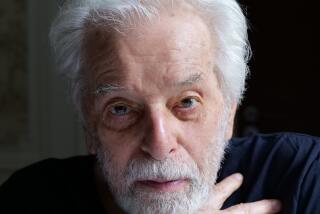Wojciech Has; Directed Polish Film Masterpiece
- Share via
Wojciech Has, an influential Polish filmmaker whose work was little seen in America but who nevertheless, with his epic “The Saragossa Manuscript,” earned such admirers as Francis Ford Coppola, Martin Scorsese and Grateful Dead guru Jerry Garcia, has died. He was 75.
Has, who suffered from diabetes, died Tuesday in a Lodz, Poland, hospital of complications after two surgeries.
His two films best known in the United States, “Saragossa” from 1965 and “The Hourglass Sanatorium” from 1973, garnered several awards at international film festivals, the latter the top prize at Cannes. An earlier feature, “How to Be Loved” in 1963, earned a Golden Gate grand prize at the San Francisco Film Festival. Has’ prize was bestowed by Luis Bunuel, who borrowed elements from “Saragossa” for his own 1967 “Belle du Jour” and subsequent masterpieces.
Has’ reputation in America rested squarely on his wide-screen, black-and-white film “The Saragossa Manuscript.”
Garcia saw the short version, cut for American consumption, during its brief screening in San Francisco in 1965, and, perhaps fueling the movie’s still-growing cult status, was so taken with it that he donated money to buy and restore Has’ original three-hour print. The print was obtained by the Pacific Film Archive only a day before Garcia died on Aug. 9, 1995. The rock musician never got to see what he paid to preserve.
Filmmakers Coppola and Scorsese supervised the restoration and sent the result on a tour across the country from 1997 to 1999--Manhattan’s Alice Tully Hall for the New York Film Festival, the Chicago Art Institute, the Castro Theatre in San Francisco and American Cinematheque’s Egyptian Theatre in Los Angeles.
When the restored film was shown in Los Angeles in 1999, The Times’ Kevin Thomas called it “a masterpiece of the macabre . . . brought to the screen with breathtaking splendor,” even though he added that the lengthy epic also had “one of the most convoluted plots in the history of the movies.”
Has’ story within a story within a story was based on the early 19th century French-language Gothic novel “The Saragossa Manuscript,” by Polish aristocrat Jan Potocki. One probably should not make too much of the fact that Potocki committed suicide shortly after writing the book.
The hero of novel and film, royal guard captain Alphonse van Worden (portrayed by actor Zbigniew Cybulski, who was considered the James Dean of Poland), has a series of fantastic adventures in the mountains of southern Spain. Van Worden encounters seductive princesses, a magician and a mathematician who struggle for control of his soul, each weaving myriad stories with characters who in turn relate their own tales.
“The deft juxtaposition of striking images of beauty and terror,” Thomas wrote, “is the equal of anything by Ingmar Bergman, a director with whom Has has much in common.”
Across the country, a New York Times reviewer asked, “What does it all mean?
“The movie is really an extended jokey meditation on reality and illusion, in a self-mocking comic style that keeps emotion at arm’s length,” he concluded, cautioning: “After emerging from this pleasurably robust storybook world, it might take you a few minutes to figure out which end is up.”
In Middle America, a Chicago Tribune critic wrote: “ ‘The Saragossa Manuscript’ is a great, unique movie, one of the classics of the ‘60s.”
He called the film “an ultimate example of movie surrealism” and said, “The effect is exhilarating and bizarre--like a picaresque epic in the vein of Don Quixote or Rabelais, subversively redesigned by M.C. Escher.
” . . . The rich wide-screen, black-and-white photography and sumptuous settings of ‘Saragossa Manuscript’ make it one of the most visually lush of all Eastern European films,” he added. “And the wittily eclectic score by noted composer Krzysztof Penderecki--going from baroque to romantic and electronic--makes it sonically lush as well.”
The Pacific Film Archive did much to foster Has’ American reputation, staging an 11-film Has retrospective in 1997, which he attended.
Born in Krakow, Has studied painting at the Polish city’s Fine Arts Academy and graduated from its Film Institute.
He began his career directing shorts and documentaries, starting with “Harmonica” in 1948. His first feature film was “The Noose” a decade later, depicting a day in the life of a suicidal alcoholic.
Has continued making films through the 1980s, with “Write and Fight” in 1985, “The Memoirs of a Sinner” in 1986 and “The Tribulations of Balthazar Kober” in 1988.
He was head of the Lodz Film School from 1990 to 1996 and, since its creation in 1990, of the Indeks Foundation to assist Lodz graduates in raising money and launching careers.
Has is survived by his wife, Wanda, and a son, Marek.
More to Read
Only good movies
Get the Indie Focus newsletter, Mark Olsen's weekly guide to the world of cinema.
You may occasionally receive promotional content from the Los Angeles Times.








